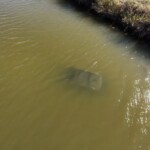Hurricane Milton is already the second-strongest Gulf hurricane in recorded history following closely behind Hurricane Rita — and experts predict the Category 5 storm will only intensify as it barrels toward Florida.
Milton’s minimum central pressure — one of the primary ways meteorologists measure hurricane strength, with lower ratings denoting greater strength — was rated at 897 millibars as of the National Hurricane Center’s (NHC) Monday night report.
That places the storm in the number two spot for the strongest hurricane to ever form in the Gulf of Mexico in recorded history — landing it just behind 2005’s devastating Hurricane Rita, which bottomed out at 895 mb.
But Milton still has a full day before it is expected to make landfall Wednesday, and Fox Weather meteorologists predicted the storm could get even stronger.
Milton’s winds are currently blowing at 180 mph as it charges toward the heart of Tampa Bay, a situation Fox Weather’s hurricane expert Bryan Narcross said could become “one of the biggest hurricane disasters in history” as it brings storm surges up to 15 feet to the low lying city.
Below are the other strongest Gulf hurricanes in history and how they stack up against Milton.
No. 1 Hurricane Rita, 2005 — 895 mb
Hurricane Rita slammed into the Louisiana coastline on September 24, 2005, as a Category 3 storm blowing at 115 mph.
It peaked three days earlier over the Gulf of Mexico as a Category 5 storm with winds at 180 mph, and set the gulf pressure record at 895 millibars, according to the National Weather Service.
As it approached the coast the storm diminished in strength but still brought with it storm surges up to 18 feet in some places.
Only seven deaths were directly blamed directly on the storm, but more than 100 were reported killed by its aftereffects, evacuations, and ensuing infrastructure accidents.
No. 3 Hurricane Allen, 1988 — 899 mb
Hurricane Allen reached a peak strength of 899 mb on August 7, 1988, with winds blowing at 190 mph.
Over the following three days it mercifully weakened, making landfall on August 10 at 115 mph and 945 mb.
The storm surge was just 5 feet, while Allen sparked an unusually high number of tornadoes across Texas that caused over two dozen injuries.
There were two deaths directly caused by the storm in the US, while more than 30 were indirectly linked.
No. 4 Hurricane Camille, 1969 — 900 mb
Hurricane Camille was one of just four Category 5 storms to make landfall on the US in recorded history.
When it struck Mississippi on August 17, 1969, it had winds of 150 mph and pressure of 900 mb.
The devastation of the storm was widespread, high winds destroying buildings, while intense rainfalls it brought to the inland US caused severe flooding.
At least 256 deaths have been directly linked to the storm.
No. 5 Hurricane Katrina, 2005 — 902 mb
Hurricane Katrina reached peak strength on August 28, 2005, at 902 mb with Category 5 winds of 175 mph.
By the time it made landfall in Louisiana on August 29 it had diminished to a Category 3 storm but the rainwaters it brought overwhelmed the New Orleans levees — which broke and flooded the city, leading to a massive loss of life that made Katrina the deadliest US hurricane in recorded history.
At least 1,392 people were killed in the storm, with some estimates placing the toll higher.








